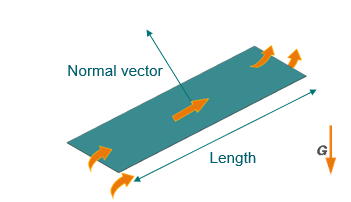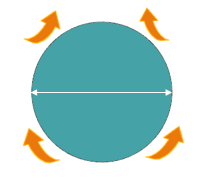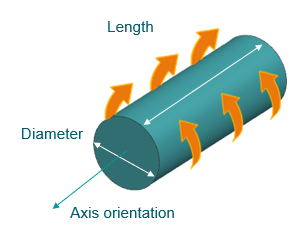Free convection correlations
Free or natural convection occurs when the heat is transferred between convective surfaces and a moving fluid, in which the fluid motion is not induced by an external force.
The magnitude of the free convection depends on the geometry of the convective surfaces. Therefore, most heat transfer correlations in natural convection are obtained empirically. Empirical correlations are obtained for different surface geometries and flow regimes, characterized by the Rayleigh number.
Free convection from the top of the horizontal plate
A plate is considered horizontal if it is within 5° of the horizontal plane.
The thermal solver computes the heat transfer from upward-facing surface of the horizontal plate with the following equations [4]:
The laminar Nusselt number is:
The turbulent Nusselt number is:
where the empirical functions are:
To obtain the Nusselt number over the entire range of the Rayleigh number, the blending equation is used:
Free convection from the bottom of the horizontal plate
The thermal solver computes the heat transfer for the downward-facing surface of the horizontal plate by the following equations [4]:
The laminar Nusselt number is:
where
Since the buoyancy force is mainly into the surface, laminar flow prevails up to very high Rayleigh numbers.
Vertical plate correlation
The thermal solver uses the vertical plate correlation when the inclined plate angle is within 10° of the vertical plane.
For a fully laminar flow along a vertical plate, the Nusselt number is:
For turbulent flow at all locations along the surface of the vertical plate, the Nusselt number is:
where the empirical functions are:
The blending equation is used:
Free convection from the top of the inclined plate
The inclined plate correlation applies when the plate angle is more than 5° from the horizontal plane and 10° from the vertical plane.

The thermal solver computes the heat transfer from the top of the inclined plate using the maximum Nusselt number of two values obtained from two correlations: free convection for the vertical plate and the top of the horizontal plate [4].
The laminar Nusselt is computed from the vertical plate correlation with an angle α deviated from the vertical in degrees:
The laminar Nusselt is computed from the horizontal plate correlation:
The total laminar Nusselt number:
The turbulent Nusselt number:
where
The blending equation is used:
Free convection from the bottom of the inclined plate
The thermal solver uses the following algorithm to compute the heat transfer coefficient from the bottom of the inclined plate:
- h1 using the correlation for the Nusselt number for the top of the horizontal plate with Ra replaced by Ra sin(α).
- h2 using the correlation for the Nusselt number for the bottom of the horizontal plate with Ra replaced by Ra sin(α).
- h3 using the correlation for the Nusselt number for the vertical plate with Ra replaced by Ra cos(α).
- h=max(h1,h2,h3)
Sphere correlation

For fully laminar flow around the sphere, the Nusselt number is [4]:
For fully turbulent flow around the sphere, the Nusselt number is:
where:
To obtain the Nusselt number over the entire range of Rayleigh number, the blending equation is used:
Free convection from the horizontal cylinder

A cylinder is considered horizontal when it is within 10° of the horizontal plane.
The laminar Nusselt number [4]:
The turbulent Nusselt number:
where
The blending equation is:
Free convection from the vertical cylinder
A cylinder is considered vertical when it is within 10° of the vertical plane.
The laminar Nusselt number for the vertical cylinder [4], L/Dc < 10:
where
- L is the length of the cylinder.
- Dc is the diameter of the cylinder.
- Nuplate is the Nusselt number computed from the blending equation of Nusselt number for vertical plate correlation.
The turbulent Nusselt number, L/Dc > 10, is:
The blending equation is:
Free convection from the inclined cylinder
A cylinder is considered inclined when it is more than 10° from the horizontal and vertical planes.
The Nusselt number is calculated from the following equations [4]:
where:
- Dc is the diameter of the cylinder.
- L is the length of the cylinder.
- α is the angular deviation from the vertical in degrees.
